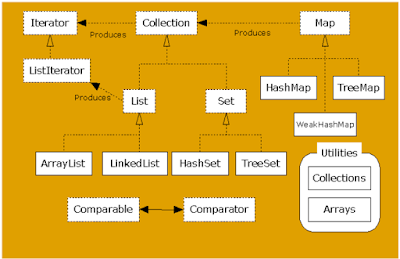There are mainly three ways :
1) Using Loop
2) System.arrayCopy();
3) Arrays.copyOf() && Arrays.copyOfRange()
Lets go in brief with array copy.
1. Using Loop
package com.my;
class Array_Loop{
public int[] copyArrayByLoop (int[] myArray){
int length = myArray.length;
int[] copy = new int [length];
for(int i=0;i<length;i++){
copy [i] = myArray[i];
}
return copy;
}
}
2. System.arrayCopy()
public static native void arraycopy(Object src, int srcPos,Object dest, int destPos,int length);
3. Arrays.copyOf() && Arrays.copyOfRange()
int []return = Arrays.copyOf(int[] array,int newLength)
byte []return = Arrays.copyOfRange(byte[] array,int from,int to)
1) Using Loop
2) System.arrayCopy();
3) Arrays.copyOf() && Arrays.copyOfRange()
Lets go in brief with array copy.
1. Using Loop
- We all know array start with index 0,so using loop you can initialize variable and put condition with array size like array_name.length (Be remember its property not method).
- Now iterate loop and copy one by one element into another array.
- Following is example for array Copy using for loop.
package com.my;
class Array_Loop{
public int[] copyArrayByLoop (int[] myArray){
int length = myArray.length;
int[] copy = new int [length];
for(int i=0;i<length;i++){
copy [i] = myArray[i];
}
return copy;
}
}
2. System.arrayCopy()
- It depends on the virtual machine, but it looks as if it copies blocks of memory instead of copying single array elements.
- This would absolutely increase performance. It's always preferred over loops when performance is an issue.
- System.arraycopy() uses JNI (Java Native Interface) to copy an array (or parts of it), so it is amazingly fast.
public static native void arraycopy(Object src, int srcPos,Object dest, int destPos,int length);
- If dest is null, then a NullPointerException is thrown.
- If src is null, then a NullPointerException is thrown and the destination array is not modified.
- Otherwise, if any of the following is true, an ArrayStoreException is thrown and the destination is not modified:
- The src argument refers to an object that is not an array.
- The dest argument refers to an object that is not an array.
- The src argument and dest argument refer to arrays whose component types are different primitive types.
- The src argument refers to an array with a primitive component type and the dest argument refers to an array with a reference component type.
- The src argument refers to an array with a reference component type and the dest argument refers to an array with a primitive component type.
- Otherwise, if any of the following is true, an IndexOutOfBoundsException is thrown and the destination is not modified:
- The srcPos argument is negative.
- The destPos argument is negative.
- The length argument is negative.
- srcPos+length is greater than src.length, the length of the source array.
- destPos+length is greater than dest.length, the length of the destination array.
3. Arrays.copyOf() && Arrays.copyOfRange()
int []return = Arrays.copyOf(int[] array,int newLength)
- Copies the specified array, truncating or padding with false (if necessary) so the copy has the specified length.
- For all indices that are valid in both the original array and the copy, the two arrays will contain identical values.
- For any indices that are valid in the copy but not the original, the copy will contain false.
- Such indices will exist if and only if the specified length is greater than that of the original array.
- Arrays.copyOf(T[], int) is easier to read. Internaly it uses System.arraycopy() which is a native call.
- NegativeArraySizeException - if newLength is negative
- NullPointerException - if array is null
byte []return = Arrays.copyOfRange(byte[] array,int from,int to)
- Copies the specified range of the specified array into a new array.
- The initial index of the range (from) must lie between zero and original.length, inclusive.
- The value at array[from] is placed into the initial element of the copy (unless from == original.length or from == to).
- Values from subsequent elements in the original array are placed into subsequent elements in the copy. The final index of the range (to), which must be greater than or equal to from, may be greater than original.length, in which case null is placed in all elements of the copy whose index is greater than or equal to original.length - from.
- The length of the returned array will be to - from.
- ArrayIndexOutOfBoundsException - if from < 0 or from > original.lengt
- IllegalArgumentException - if from > to
- NullPointerException - if original is null


